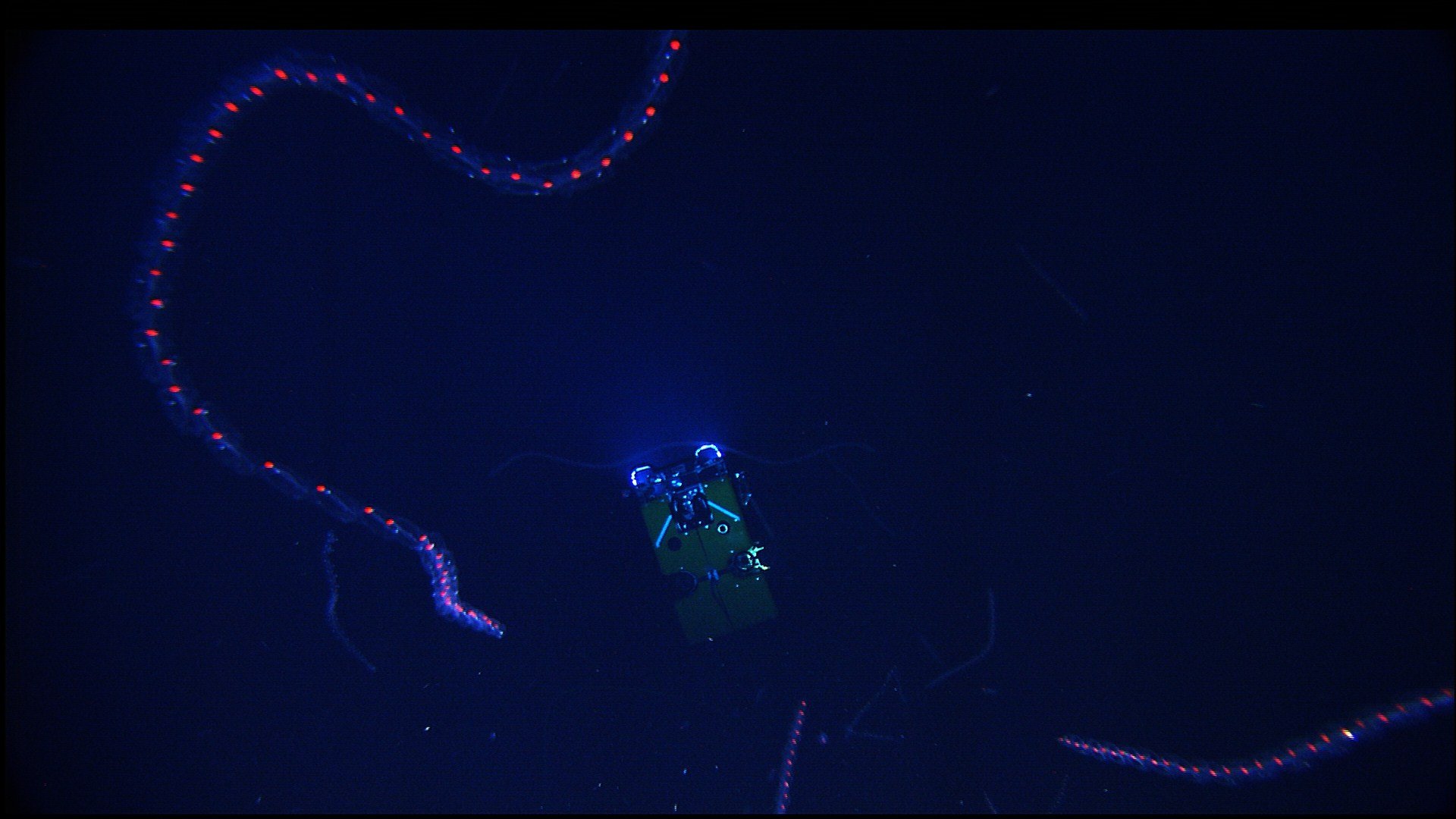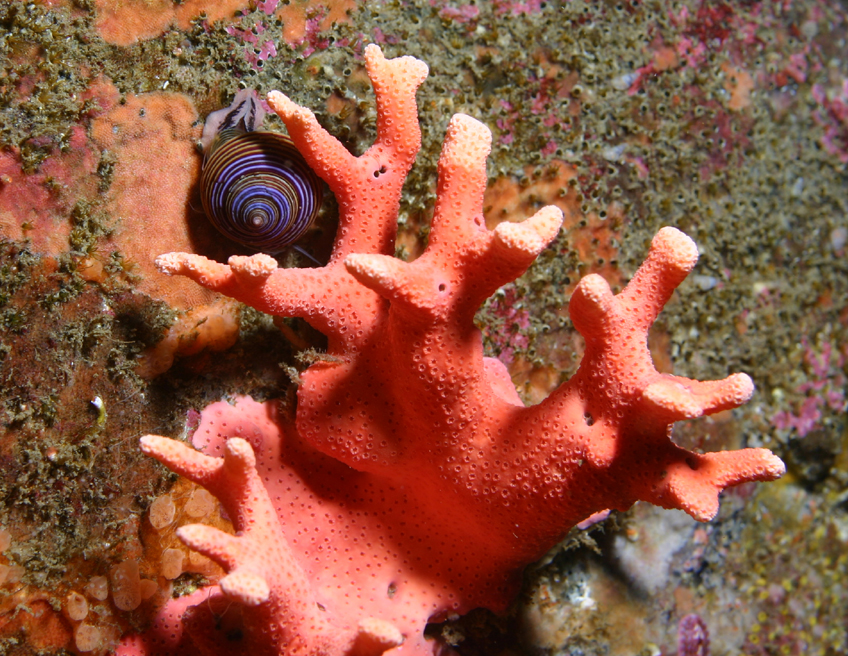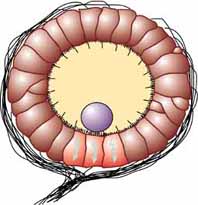|
Leptothecata
Leptothecata, or thecate hydroids, are an order of hydrozoans in the phylum Cnidaria. Their closest living relatives are the athecate hydroids, which are similar enough to have always been considered closely related, and the very apomorphic Siphonophorae, which were placed outside the "Hydroida". Given that there are no firm rules for synonymy for high-ranked taxa, alternative names like Leptomedusa, Thecaphora or Thecata, with or without the ending emended to "-ae", are also often used for Leptothecata. Leptothecata is surrounded by a chitinous outer layer as its exoskeleton, including gonophores, their reproductive organ. Leptothecata obtain radial symmetry, in which their gonads can be found in their radial canals. Their morphological characters normally have ranged from benthic to planktonic stages. Characters associated with benthic are the polyps and colony forms, while planktonic is medusae. Leptothecata has a vast and complex variation among all species within the hydrozo ... [...More Info...] [...Related Items...] OR: [Wikipedia] [Google] [Baidu] |
Conica (Hydrozoa)
Conica are a cnidarian suborder of the Leptomedusae (thecate hydroids). They make up the bulk of their order; their internal relationships are not well resolved, and most of the roughly 30 families are not yet assigned to a superfamily. They are named for the distinctive shape of their hypostome, the "tip" of the polyps' body where the mouth is located. As opposed to the smaller thecate suborder Proboscidoidea with their elongated hypostome, the Conica have a simple hypostome without a pregastric cavity and a shape that is generally round or conical. Well-known members of the Conica are the "air fern" (''Sertilaria argentea'') of the Sertulariidae which is sold dried as novelty "plants" and aquarium ornaments, and the Crystal Jelly (''Aequorea victoria'') of the Aequoreidae, a bioluminescent hydrozoan. Systematics Apart from the families assigned to the three named superfamilies, there are many Conica that are presently unassigned as to superfamily, either because thei ... [...More Info...] [...Related Items...] OR: [Wikipedia] [Google] [Baidu] |
Siphonophorae
Siphonophorae (from Greek ''siphōn'' 'tube' + ''pherein'' 'to bear') is an order within Hydrozoa, which is a class of marine organisms within the phylum Cnidaria. According to the World Register of Marine Species, the order contains 175 species thus far. Although a siphonophore may appear to be an individual organism, each specimen is in fact a colonial organism composed of medusoid and polypoid zooids that are morphologically and functionally specialized. Zooids are multicellular units that develop from a single fertilized egg and combine to create functional colonies able to reproduce, digest, float, maintain body positioning, and use jet propulsion to move. Most colonies are long, thin, transparent floaters living in the pelagic zone. Like other hydrozoans, some siphonophores emit light to attract and attack prey. While many sea animals produce blue and green bioluminescence, a siphonophore in the genus ''Erenna'' was only the second life form found to produce a red li ... [...More Info...] [...Related Items...] OR: [Wikipedia] [Google] [Baidu] |
Aequoreidae
Aequoreidae is a family of hydrozoans, sometimes called the many-ribbed jellies or many-ribbed jellyfish. There are approximately 30 known species found in temperate and tropical marine coastal environments. Aequoreids include ''Aequorea victoria'', the organism from which the green fluorescent protein gene was isolated. Polyps Only the polyp stages of '' Aequorea'' species have been observed. The colonies are covered with chitinous periderm and can be either prostrate or erect with weak or sympodial branching. Young possess with a closing structure called '' operculum'', which consists of several relatively long triangular folds that meet together in the centre when a disturbed polyp contracts. Because the operculum is quite fragile, hydrothecae of old polyps usually have only a small chitinous collar remaining. Comparatively large cylindrical are attached to the colony with a thin peduncle. Commonly only one medusa develops in each gonotheca. Medusae Mature aequoreid medus ... [...More Info...] [...Related Items...] OR: [Wikipedia] [Google] [Baidu] |
Medusa (biology)
Jellyfish and sea jellies are the informal common names given to the medusa-phase of certain gelatinous members of the subphylum Medusozoa, a major part of the phylum Cnidaria. Jellyfish are mainly free-swimming marine animals with umbrella-shaped bells and trailing tentacles, although a few are anchored to the seabed by stalks rather than being mobile. The bell can pulsate to provide propulsion for highly efficient locomotion. The tentacles are armed with stinging cells and may be used to capture prey and defend against predators. Jellyfish have a complex life cycle; the medusa is normally the sexual phase, which produces planula larvae that disperse widely and enter a sedentary polyp phase before reaching sexual maturity. Jellyfish are found all over the world, from surface waters to the deep sea. Scyphozoans (the "true jellyfish") are exclusively marine, but some hydrozoans with a similar appearance live in freshwater. Large, often colorful, jellyfish are common in coa ... [...More Info...] [...Related Items...] OR: [Wikipedia] [Google] [Baidu] |
Whorl (biology)
A whorl ( or ) is an individual circle, oval, volution or equivalent in a whorled pattern, which consists of a spiral or multiple concentric objects (including circles, ovals and arcs). Whorls in nature File:Photograph and axial plane floral diagram of Friesodielsia desmoides.jpg, Botanical whorls: sepals, petals, leaves, or branches radiating from a single point (photo and axial cross-section shown) File:Anisus septegyrus1pl.jpg, Mollusc whorls: Each complete 360° turn in the spiral growth of a mollusc shell. File:Baby hairy head DSCN2483.jpg, A hair whorl is a patch of hair growing in a circular direction around a visible center point. File:Fingerprint Whorl.jpg, In a fingerprint, a whorl is each ridge arranged circularly around a central point on the finger. File:Bovine Bone Sample and 430 times Magnification.jpg, In histopathologic architecture, a whorled pattern consists of multiple concentric objects, or a spiral-shaped pattern. Bone tissue is shown. For mollusc whor ... [...More Info...] [...Related Items...] OR: [Wikipedia] [Google] [Baidu] |
Tentacle
In zoology, a tentacle is a flexible, mobile, and elongated organ present in some species of animals, most of them invertebrates. In animal anatomy, tentacles usually occur in one or more pairs. Anatomically, the tentacles of animals work mainly like muscular hydrostats. Most forms of tentacles are used for grasping and feeding. Many are sensory organs, variously receptive to touch, vision, or to the smell or taste of particular foods or threats. Examples of such tentacles are the eyestalks of various kinds of snails. Some kinds of tentacles have both sensory and manipulatory functions. A tentacle is similar to a cirrus, but a cirrus is an organ that usually lacks the tentacle's strength, size, flexibility, or sensitivity. A nautilus has cirri, but a squid has tentacles. Invertebrates Molluscs Many molluscs have tentacles of one form or another. The most familiar are those of the pulmonate land snails, which usually have two sets of tentacles on the head: when extended ... [...More Info...] [...Related Items...] OR: [Wikipedia] [Google] [Baidu] |
Gonotheca
''Oldenlandia'' is a genus of flowering plants in the family Rubiaceae. It is pantropical in distribution and has about 240 species.Inge Groeninckx, Steven Dessein, Helga Ochoterena, Claes Persson, Timothy J. Motley, Jesper Kårehed, Birgitta Bremer, Suzy Huysmans, and Erik Smets. 2009. "Phylogeny of the herbaceous tribe Spermacoceae (Rubiaceae) based on plastid DNA data". ''Annals of the Missouri Botanical Garden'' 96(1):109–132.David J. Mabberley. 2008. ''Mabberley's Plant-Book'' third edition (2008). Cambridge University Press: UK. The type species for the genus is ''Oldenlandia corymbosa''.''Oldenlandia'' In: Index Nominum Genericorum. In: Regnum Vegetabile (see ''External links'' below). ''Oldenlandia'' was named by Linnaeus in 1753 in Species Plantarum.Carolus Linnaeus. 1753. ''Species Plantarum'' 1:119. Laurentii Salvii. (see ''External Links'' below). The name honors the Danish botanist Henrik Bernard Oldenland (1697).Umberto Quattrocchi. 2000. ''CRC World Dictionary ... [...More Info...] [...Related Items...] OR: [Wikipedia] [Google] [Baidu] |
Sporosac
{{Short pages monitor ... [...More Info...] [...Related Items...] OR: [Wikipedia] [Google] [Baidu] |
Gonad
A gonad, sex gland, or reproductive gland is a mixed gland that produces the gametes and sex hormones of an organism. Female reproductive cells are egg cells, and male reproductive cells are sperm. The male gonad, the testicle, produces sperm in the form of spermatozoa. The female gonad, the ovary, produces egg cells. Both of these gametes are haploid cells. Some hermaphroditic animals have a type of gonad called an ovotestis. Evolution It is hard to find a common origin for gonads, but gonads most likely evolved independently several times. Regulation The gonads are controlled by luteinizing hormone and follicle-stimulating hormone, produced and secreted by gonadotropes or gonadotrophins in the anterior pituitary gland. This secretion is regulated by gonadotropin-releasing hormone produced in the hypothalamus. Development Gonads start developing as a common primordium (an organ in the earliest stage of development), in the form of genital ridges, which are only l ... [...More Info...] [...Related Items...] OR: [Wikipedia] [Google] [Baidu] |
Crystal Jelly
''Aequorea victoria'', also sometimes called the crystal jelly, is a bioluminescent hydrozoan jellyfish, or hydromedusa, that is found off the west coast of North America. The species is best known as the source of two proteins involved in bioluminescence, aequorin, a photoprotein, and green fluorescent protein (GFP). Their discoverers, Osamu Shimomura and colleagues, won the 2008 Nobel Prize in Chemistry for their work on GFP. Description Almost entirely transparent and colorless, and sometimes difficult to resolve, ''Aequorea victoria'' possess a highly contractile mouth and manubrium at the center of up to 100 radial canals that extend to the bell margin. The bell margin is surrounded by uneven tentacles, up to 150 of them in fully-grown specimens. The tentacles possess nematocysts that aid in prey capture, although they have no effect on humans. Specimens larger than 3 cm usually possess gonads for sexual reproduction, which run most of the length of the radial canals ... [...More Info...] [...Related Items...] OR: [Wikipedia] [Google] [Baidu] |
Anthoathecata
Anthoathecata, or the athecate hydroids, are an order of hydrozoans belonging to the phylum Cnidaria. A profusion of alternate scientific names exists for this long-known, heavily discussed, and spectacular group. It has also been called Gymnoblastea and (with or without an emended ending ''-ae''), Anthomedusa, Athecata, Hydromedusa, and Stylasterina. There are about 1,200 species worldwide.Schuchert, P. (2014). Anthoathecata. Accessed through: Schuchert, P. (2014) World Hydrozoa database at http://www.marinespecies.org/hydrozoa/aphia.php?p=taxdetails&id=13551 on 2014-10-31 These hydrozoans always have a polyp stage. Their hydranths grow either solitary or in colonies. There is no firm perisarc around the polyp body. The medusae, or jellyfish, are solitary animals, with tentacles arising from the bell margin, lacking statocysts but possessing radial canals. Their gonads are on the manubrium ("handle").Bouillon, J.; Gravili, C.; Pagès, F.; Gili, J.-M.; Boero, F. (2006). An intro ... [...More Info...] [...Related Items...] OR: [Wikipedia] [Google] [Baidu] |
Statocyst
The statocyst is a balance sensory receptor present in some aquatic invertebrates, including bivalves, cnidarians, ctenophorans, echinoderms, cephalopods, and crustaceans. A similar structure is also found in ''Xenoturbella''. The statocyst consists of a sac-like structure containing a mineralised mass (statolith) and numerous innervated sensory hairs (setae). The statolith's inertia causes it to push against the setae when the animal accelerates. Deflection of setae by the statolith in response to gravity activates neurons, providing feedback to the animal on change in orientation and allowing balance to be maintained. In other words, the statolith shifts as the animal moves. Any movement large enough to throw the organism off balance causes the statolith to brush against tiny bristles which in turn send a message to the brain to correct its balance. It may have been present in the common ancestor of cnidarians and bilaterians. Hearing In cephalopods like squids, statocysts ... [...More Info...] [...Related Items...] OR: [Wikipedia] [Google] [Baidu] |







